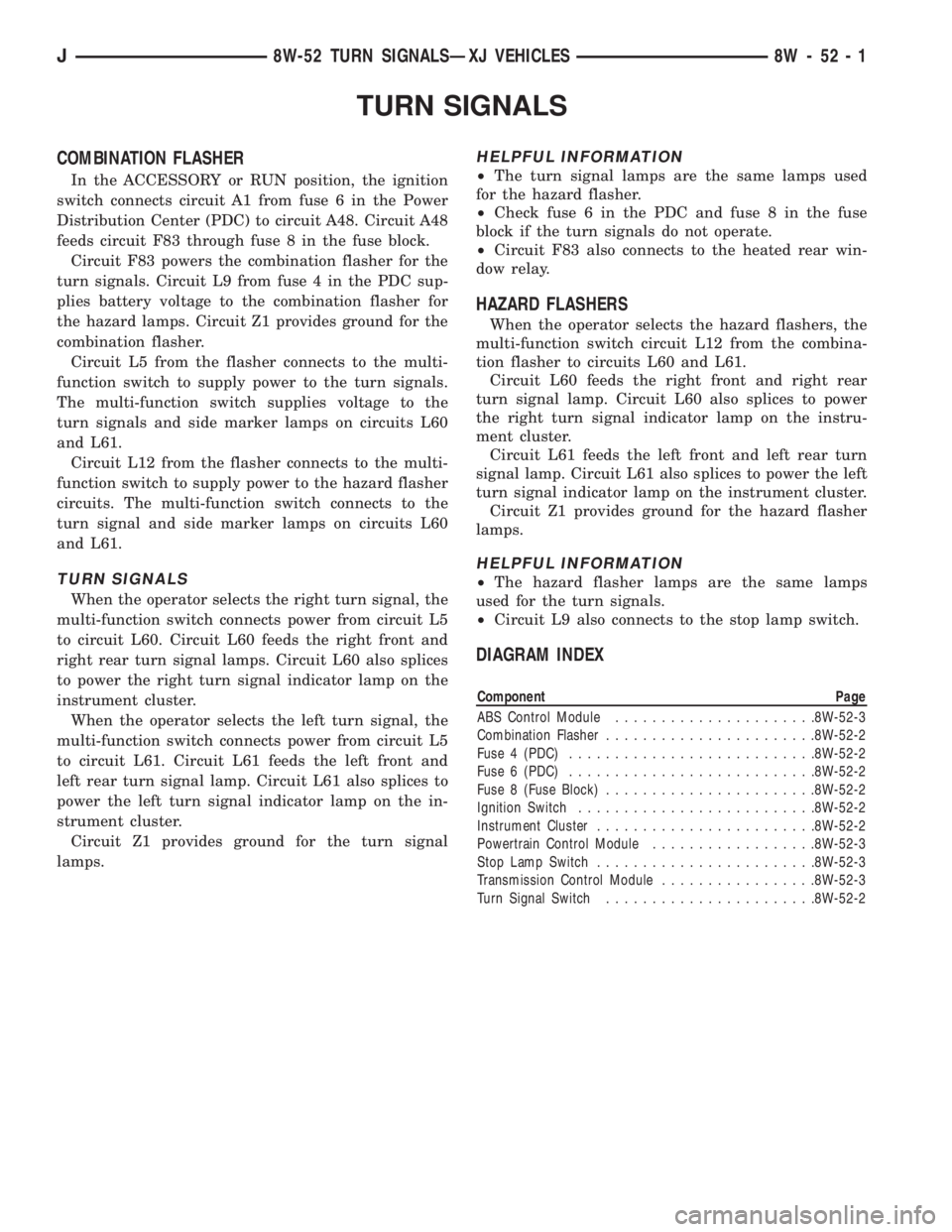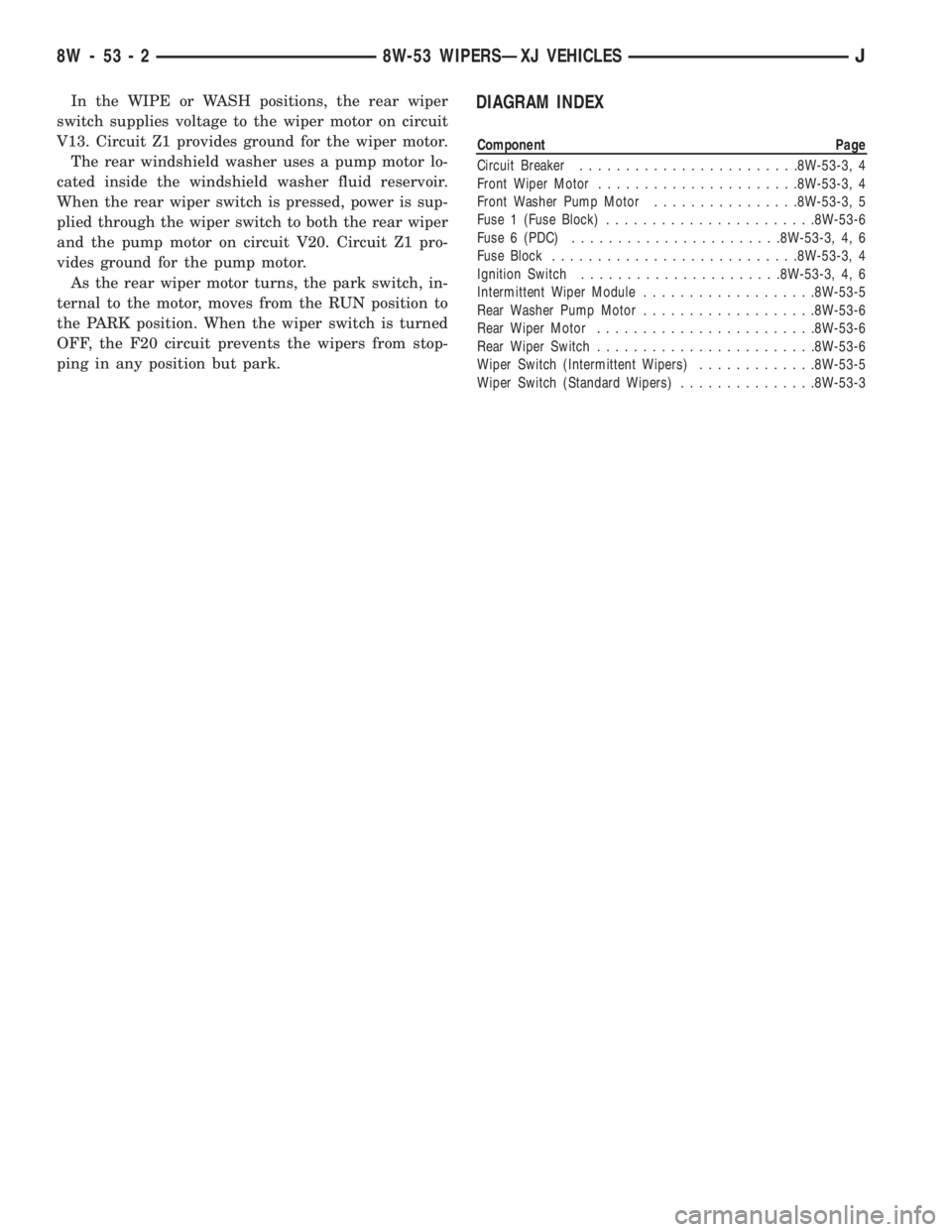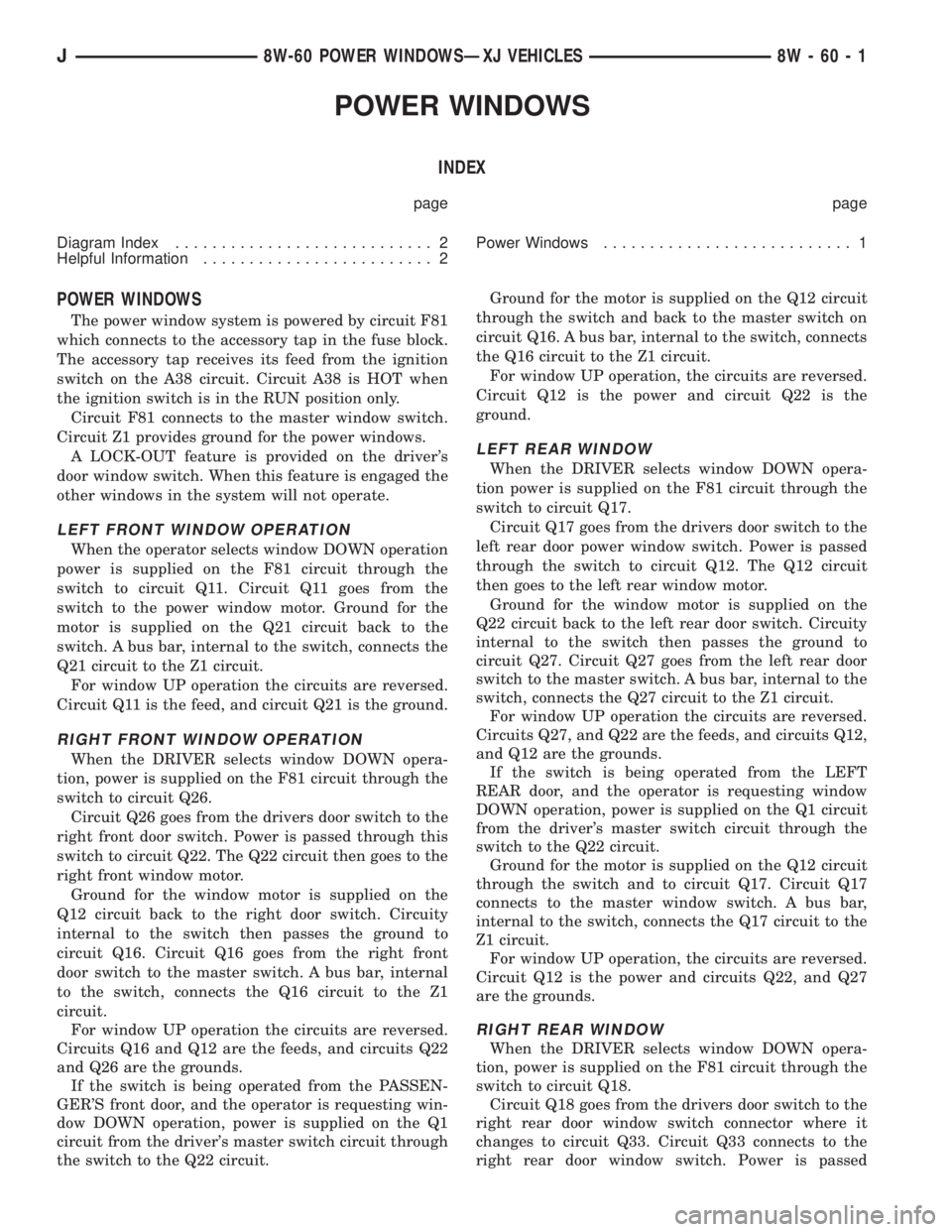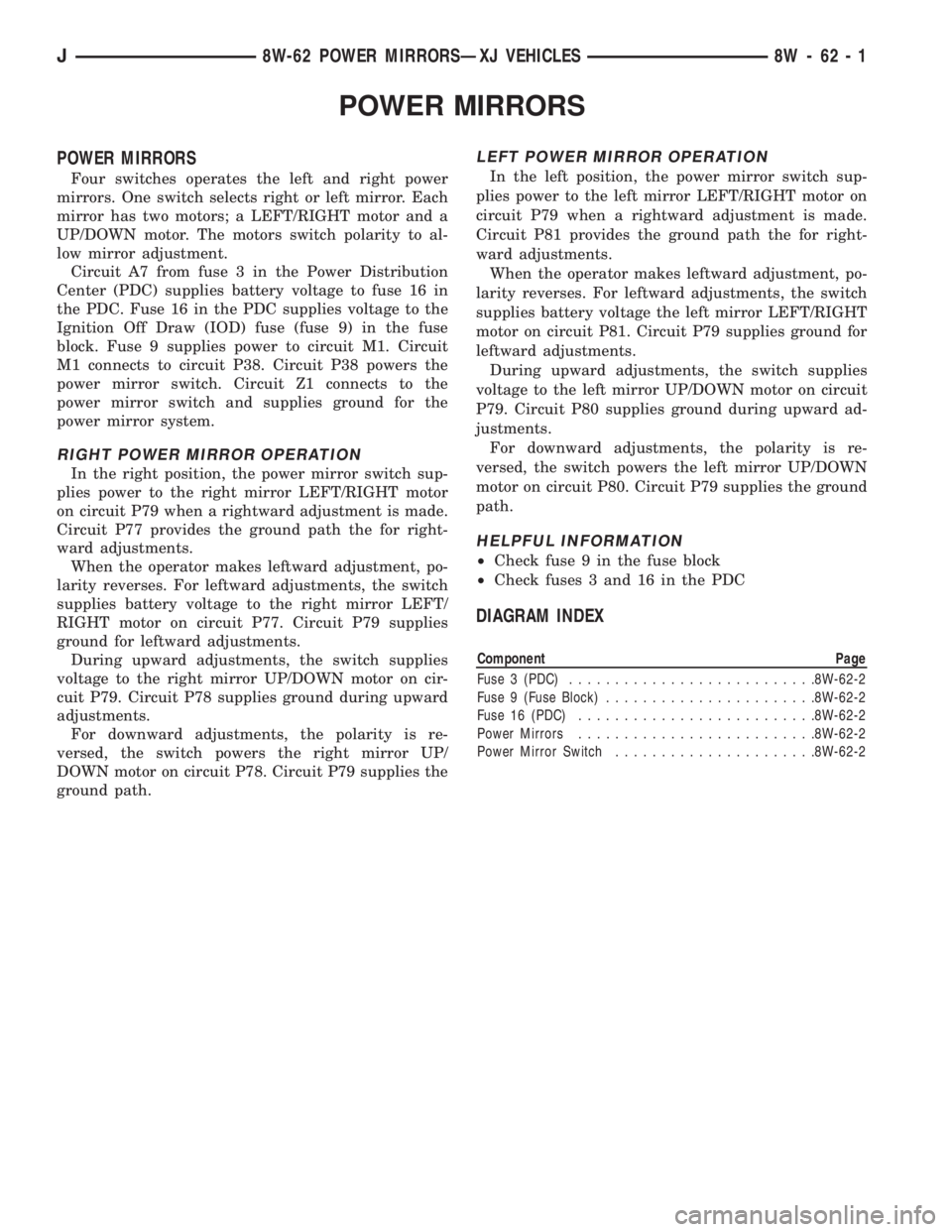1995 JEEP YJ ignition
[x] Cancel search: ignitionPage 682 of 2158

TURN SIGNALS
COMBINATION FLASHER
In the ACCESSORY or RUN position, the ignition
switch connects circuit A1 from fuse 6 in the Power
Distribution Center (PDC) to circuit A48. Circuit A48
feeds circuit F83 through fuse 8 in the fuse block.
Circuit F83 powers the combination flasher for the
turn signals. Circuit L9 from fuse 4 in the PDC sup-
plies battery voltage to the combination flasher for
the hazard lamps. Circuit Z1 provides ground for the
combination flasher.
Circuit L5 from the flasher connects to the multi-
function switch to supply power to the turn signals.
The multi-function switch supplies voltage to the
turn signals and side marker lamps on circuits L60
and L61.
Circuit L12 from the flasher connects to the multi-
function switch to supply power to the hazard flasher
circuits. The multi-function switch connects to the
turn signal and side marker lamps on circuits L60
and L61.
TURN SIGNALS
When the operator selects the right turn signal, the
multi-function switch connects power from circuit L5
to circuit L60. Circuit L60 feeds the right front and
right rear turn signal lamps. Circuit L60 also splices
to power the right turn signal indicator lamp on the
instrument cluster.
When the operator selects the left turn signal, the
multi-function switch connects power from circuit L5
to circuit L61. Circuit L61 feeds the left front and
left rear turn signal lamp. Circuit L61 also splices to
power the left turn signal indicator lamp on the in-
strument cluster.
Circuit Z1 provides ground for the turn signal
lamps.
HELPFUL INFORMATION
²The turn signal lamps are the same lamps used
for the hazard flasher.
²Check fuse 6 in the PDC and fuse 8 in the fuse
block if the turn signals do not operate.
²Circuit F83 also connects to the heated rear win-
dow relay.
HAZARD FLASHERS
When the operator selects the hazard flashers, the
multi-function switch circuit L12 from the combina-
tion flasher to circuits L60 and L61.
Circuit L60 feeds the right front and right rear
turn signal lamp. Circuit L60 also splices to power
the right turn signal indicator lamp on the instru-
ment cluster.
Circuit L61 feeds the left front and left rear turn
signal lamp. Circuit L61 also splices to power the left
turn signal indicator lamp on the instrument cluster.
Circuit Z1 provides ground for the hazard flasher
lamps.
HELPFUL INFORMATION
²The hazard flasher lamps are the same lamps
used for the turn signals.
²Circuit L9 also connects to the stop lamp switch.
DIAGRAM INDEX
Component Page
ABS Control Module......................8W-52-3
Combination Flasher.......................8W-52-2
Fuse 4 (PDC)...........................8W-52-2
Fuse 6 (PDC)...........................8W-52-2
Fuse 8 (Fuse Block).......................8W-52-2
Ignition Switch..........................8W-52-2
Instrument Cluster........................8W-52-2
Powertrain Control Module..................8W-52-3
Stop Lamp Switch........................8W-52-3
Transmission Control Module.................8W-52-3
Turn Signal Switch.......................8W-52-2
J8W-52 TURN SIGNALSÐXJ VEHICLES 8W - 52 - 1
Page 685 of 2158

WIPERS
INDEX
page page
Diagram Index............................ 2
Rear Wiper System......................... 1WipersÐIntermittent........................ 1
WipersÐStandard.......................... 1
WIPERSÐSTANDARD
A circuit breaker powers the standard wiper sys-
tem. The standard wiper system operates at either
LOW or HIGH speeds.
In the ACCESSORY or RUN position, the ignition
switch connects circuit A1 from fuse 6 in the Power
Distribution Center (PDC) with circuit A48. Circuit
A48 supplies voltage to circuit F86 through the circuit
breaker near the left kick panel.
Circuit F86 is double crimped at the circuit breaker
and supplies power to the wiper switch and the park
switch in the wiper motor. Circuit Z1 from the wiper
motor provides ground for the wiper motor and
switch.
When the operator moves the wiper switch to the
LOW position, battery voltage passes through the
switch to circuit V3. Circuit V3 feeds the wiper motor
low speed brushes. If the operator selects wiper
HIGH speed operation, the wiper switch passes cur-
rent to circuit V4. Circuit V4 feeds the wiper motor
high speed brushes.
As the windshield wiper motor turns, the park
switch, internal to the motor, moves from its DOWN
position to the UP position. When the wiper switch is
turned OFF, the V55 circuit prevents the wipers from
stopping in any position but park.
The windshield washer uses a pump motor located
inside the windshield washer fluid reservoir. When
the washer switch is pressed, power is supplied
through the wiper switch to the pump motor on cir-
cuit V10. Circuit Z1 provide ground for the pump
motor.
HELPFUL INFORMATION
Circuit Z1 also provides ground for the rear wiper
washer pump, radiator fan motor and front end light-
ing.
WIPERSÐINTERMITTENT
A circuit breaker powers the standard wiper sys-
tem. The intermittent wiper system operates at either
LOW or HIGH or DELAY speeds.
In the ACCESSORY or RUN position, the ignition
switch connects circuit A1 from fuse 6 in the PDC
with circuit A48. Circuit A48 supplies voltage to cir-
cuit F86 through the circuit breaker near the left kick
panel.Circuit F86 is double crimped at the circuit breaker
and supplies power to the wiper switch and the park
switch in the wiper motor. Circuit Z1 from the wiper
motor provides ground for the wiper motor and
switch.
When the operator moves the wiper switch to the
LOW position, battery voltage passes through the
switch to circuit V3. Circuit V3 feeds the wiper motor
low speed brushes. If the operator selects wiper
HIGH speed operation, the wiper switch passes cur-
rent to circuit V4. Circuit V4 feeds the wiper motor
high speed brushes.
The DELAY portion of the wiper switch contains a
variable resistor. The variable resistor connects to the
intermittent wiper module through the wiper switch
harness. The amount of delay selected by the operator
determines the voltage drop through the resistor and
the voltage level received by the intermittent wiper
module.
After the intermittent wiper control module deter-
mines the amount of delay selected, it cycles the
wipers by periodically energizing circuit V3. Circuit
V3 powers the wiper motor low speed brushes.
As the windshield wiper motor turns, the park
switch, internal to the motor, moves from its DOWN
position to the UP position. When the wiper switch is
turned OFF, the V55 circuit prevents the wipers from
stopping in any position but park.
The windshield washer uses a pump motor located
inside the windshield washer fluid reservoir. When
the washer switch is pressed, power is supplied
through the wiper switch to the pump motor on cir-
cuit V10. Circuit Z1 provides ground for the pump
motor.
HELPFUL INFORMATION
Circuit Z1 also provides ground for the rear wiper
washer pump, radiator fan motor and front end light-
ing.
REAR WIPER SYSTEM
In the RUN position, the ignition switch connects
circuit A1 from fuse 6 in the PDC with circuit A38.
Circuit A38 connects to a fuse block bus bar that
powers circuit V15 through the fuse in cavity 1. Cir-
cuit V15 supplies power to the rear wiper switch.
J8W-53 WIPERSÐXJ VEHICLES 8W - 53 - 1
Page 686 of 2158

In the WIPE or WASH positions, the rear wiper
switch supplies voltage to the wiper motor on circuit
V13. Circuit Z1 provides ground for the wiper motor.
The rear windshield washer uses a pump motor lo-
cated inside the windshield washer fluid reservoir.
When the rear wiper switch is pressed, power is sup-
plied through the wiper switch to both the rear wiper
and the pump motor on circuit V20. Circuit Z1 pro-
vides ground for the pump motor.
As the rear wiper motor turns, the park switch, in-
ternal to the motor, moves from the RUN position to
the PARK position. When the wiper switch is turned
OFF, the F20 circuit prevents the wipers from stop-
ping in any position but park.DIAGRAM INDEX
Component Page
Circuit Breaker........................8W-53-3, 4
Front Wiper Motor......................8W-53-3, 4
Front Washer Pump Motor................8W-53-3, 5
Fuse 1 (Fuse Block).......................8W-53-6
Fuse 6 (PDC).......................8W-53-3, 4, 6
Fuse Block...........................8W-53-3, 4
Ignition Switch......................8W-53-3, 4, 6
Intermittent Wiper Module...................8W-53-5
Rear Washer Pump Motor...................8W-53-6
Rear Wiper Motor........................8W-53-6
Rear Wiper Switch........................8W-53-6
Wiper Switch (Intermittent Wipers).............8W-53-5
Wiper Switch (Standard Wipers)...............8W-53-3
8W - 53 - 2 8W-53 WIPERSÐXJ VEHICLESJ
Page 695 of 2158

POWER WINDOWS
INDEX
page page
Diagram Index............................ 2
Helpful Information......................... 2Power Windows........................... 1
POWER WINDOWS
The power window system is powered by circuit F81
which connects to the accessory tap in the fuse block.
The accessory tap receives its feed from the ignition
switch on the A38 circuit. Circuit A38 is HOT when
the ignition switch is in the RUN position only.
Circuit F81 connects to the master window switch.
Circuit Z1 provides ground for the power windows.
A LOCK-OUT feature is provided on the driver's
door window switch. When this feature is engaged the
other windows in the system will not operate.
LEFT FRONT WINDOW OPERATION
When the operator selects window DOWN operation
power is supplied on the F81 circuit through the
switch to circuit Q11. Circuit Q11 goes from the
switch to the power window motor. Ground for the
motor is supplied on the Q21 circuit back to the
switch. A bus bar, internal to the switch, connects the
Q21 circuit to the Z1 circuit.
For window UP operation the circuits are reversed.
Circuit Q11 is the feed, and circuit Q21 is the ground.
RIGHT FRONT WINDOW OPERATION
When the DRIVER selects window DOWN opera-
tion, power is supplied on the F81 circuit through the
switch to circuit Q26.
Circuit Q26 goes from the drivers door switch to the
right front door switch. Power is passed through this
switch to circuit Q22. The Q22 circuit then goes to the
right front window motor.
Ground for the window motor is supplied on the
Q12 circuit back to the right door switch. Circuity
internal to the switch then passes the ground to
circuit Q16. Circuit Q16 goes from the right front
door switch to the master switch. A bus bar, internal
to the switch, connects the Q16 circuit to the Z1
circuit.
For window UP operation the circuits are reversed.
Circuits Q16 and Q12 are the feeds, and circuits Q22
and Q26 are the grounds.
If the switch is being operated from the PASSEN-
GER'S front door, and the operator is requesting win-
dow DOWN operation, power is supplied on the Q1
circuit from the driver's master switch circuit through
the switch to the Q22 circuit.Ground for the motor is supplied on the Q12 circuit
through the switch and back to the master switch on
circuit Q16. A bus bar, internal to the switch, connects
the Q16 circuit to the Z1 circuit.
For window UP operation, the circuits are reversed.
Circuit Q12 is the power and circuit Q22 is the
ground.
LEFT REAR WINDOW
When the DRIVER selects window DOWN opera-
tion power is supplied on the F81 circuit through the
switch to circuit Q17.
Circuit Q17 goes from the drivers door switch to the
left rear door power window switch. Power is passed
through the switch to circuit Q12. The Q12 circuit
then goes to the left rear window motor.
Ground for the window motor is supplied on the
Q22 circuit back to the left rear door switch. Circuity
internal to the switch then passes the ground to
circuit Q27. Circuit Q27 goes from the left rear door
switch to the master switch. A bus bar, internal to the
switch, connects the Q27 circuit to the Z1 circuit.
For window UP operation the circuits are reversed.
Circuits Q27, and Q22 are the feeds, and circuits Q12,
and Q12 are the grounds.
If the switch is being operated from the LEFT
REAR door, and the operator is requesting window
DOWN operation, power is supplied on the Q1 circuit
from the driver's master switch circuit through the
switch to the Q22 circuit.
Ground for the motor is supplied on the Q12 circuit
through the switch and to circuit Q17. Circuit Q17
connects to the master window switch. A bus bar,
internal to the switch, connects the Q17 circuit to the
Z1 circuit.
For window UP operation, the circuits are reversed.
Circuit Q12 is the power and circuits Q22, and Q27
are the grounds.
RIGHT REAR WINDOW
When the DRIVER selects window DOWN opera-
tion, power is supplied on the F81 circuit through the
switch to circuit Q18.
Circuit Q18 goes from the drivers door switch to the
right rear door window switch connector where it
changes to circuit Q33. Circuit Q33 connects to the
right rear door window switch. Power is passed
J8W-60 POWER WINDOWSÐXJ VEHICLES 8W - 60 - 1
Page 696 of 2158

through this switch to circuit Q22. The Q22 circuit
then goes to the right rear window motor.
Ground for the window motor is supplied on the
Q12 circuit back to the right rear door switch. Circu-
ity internal to the switch then passes the ground to
circuit Q28. Circuit Q28 goes from the right rear door
switch to the master switch. A bus bar, internal to
the switch, connects the Q28 circuit to the Z1 circuit.
For window UP operation the circuits are reversed.
Circuits Q28 and Q12 are the feeds, and circuits Q22,
Q33 and Q18 are the grounds.
If the switch is being operated from the RIGHT
REAR door, and the operator is requesting window
DOWN operation, power is supplied on the Q1 circuit
from the driver's master switch circuit through the
switch to the Q22 circuit.
Ground for the motor is supplied on the Q12 circuit
through the switch and back to the master switch on
circuit Q28. A bus bar, internal to the switch, con-
nects the Q28 circuit to the Z1 circuit.
For window UP operation, the circuits are reversed.
Circuit Q12 is the power and circuit Q22 is the
ground.HELPFUL INFORMATION
²When the ignition switch is in the RUN position, it
connects circuit A1 from fuse 11 in the Power Distri-
bution Center (PDC) to circuit A38.
²Refer to the appropriate group of the Service Man-
ual for test procedures.
DIAGRAM INDEX
Component Page
Circuit Breaker (Fuse Block Cavity 6)............8W-60-3
Fuse 6 (PDC)...........................8W-60-3
Ignition Switch..........................8W-60-3
Power Window Door Switches................8W-60-4
Power Window Master Switch................8W-60-3
Power Window Motors.....................8W-60-4
8W - 60 - 2 8W-60 POWER WINDOWSÐXJ VEHICLESJ
Page 699 of 2158

POWER DOOR LOCKS
POWER DOOR LOCKS
Two relays provide power for the power door lock
motors. The Unlock relay provides power for the un-
lock circuits while the Lock relay powers the lock cir-
cuits. Either the power door lock switches or the
remote keyless entry module operate the Unlock and
Lock relays.
LOCK RELAY
Circuit M1 from fuse 9 in the fuse block powers cir-
cuit P38. When either power door lock switch is put
in the LOCK position, the switch connects circuit P38
to circuit P35. If the operator uses Remote Keyless
Entry (RKE), the RKE module powers circuit P35. In
either case, circuit P35 supplies power to the coil side
of the lock relay, causing the relay contacts to close.
Circuit Z1 provides ground for the coil side of the
lock relay.
When the lock relay contacts close, they connect
battery voltage from circuit P37 to circuit P2. Circuit
P2 then supplies battery voltage to the power door
lock motors to LOCK the doors.
When the power doors LOCK, ground for the mo-
tors is on circuit P34 through the normally closed
contacts in the door unlock relay to ground on circuit
Z1.
UNLOCK RELAY
Circuit M1 from fuse 9 in the fuse block powers cir-
cuit P38. When either power door lock switch is put
in the UNLOCK position, the switch connects circuit
P38 to circuit P36. If the operator uses Remote Key-
less Entry (RKE), the RKE module powers circuit
P36. In either case, circuit P36 supplies power to the
coil side of the unlock relay, causing the relay con-
tacts to close. Circuit Z1 provides ground for the coil
side of the unlock relay.
When the unlock relay contacts close, they connect
battery voltage from circuit P37 to circuit P34. Cir-
cuit P34 then supplies battery voltage to the power
door lock motors to UNLOCK the doors.
When the power doors UNLOCK, ground for the
motors is on circuit P2 through the normally closed
contacts in the door lock relay to ground on circuit
Z1.
REMOTE KEYLESS ENTRY MODULE
Circuit M1 from the ignition off draw (IOD) fuse in
cavity 9 of the fuse block supplies power to the Re-
mote Keyless Entry (RKE) module. Circuit F87 from
fuse 17 in the fuse block supplies power to the RKE
module when the ignition switch is in the START or
RUN position. Circuit Z1 provides ground for the
RKE module.
The RKE module UNLOCKS the doors by energiz-
ing the unlock relay on circuit P36. Refer to Unlock
Relay.
The module LOCKS the doors by energizing the
lock relay on circuit P35. Refer to Lock Relay.
HELPFUL INFORMATION
²Fuse 13 in the fuse block powers circuit P37. Cir-
cuit A7 from fuse 3 in the PDC feeds fuse 13 in the
fuse block.
²Circuit A7 from fuse 3 in the PDC also feeds fuse
16 in the PDC. PDC fuse 16 powers fuse 9 in the
fuse block. Fuse 9 protects the M1 circuit.
DIAGRAM INDEX
Component Page
Chime/Buzzer Module......................8W-61-5
Fuse 3 (PDC).........................8W-61-2, 6
Fuse 6 (PDC)...........................8W-61-5
Fuse 9 (Fuse Block).......................8W-61-2
Fuse 11 (Fuse Block)......................8W-61-2
Fuse 13 (Fuse Block)......................8W-61-2
Fuse 14 (Fuse Block)......................8W-61-2
Fuse 16 (PDC)........................8W-61-2, 6
Fuse 17 (Fuse Block)......................8W-61-5
Headlamp Delay Module....................8W-61-5
Ignition Switch..........................8W-61-5
Liftgate Lock Motor.......................8W-61-4
Power Door Lock Motors...................8W-61-4
Power Door Lock Relay....................8W-61-3
Power Door Lock Switches..................8W-61-2
Power Door Unlock Relay...................8W-61-3
Remote Keyless Entry (RKE) Module............8W-61-6
Telltale Connector........................8W-61-5
J8W-61 POWER DOOR LOCKSÐXJ VEHICLES 8W - 61 - 1
Page 705 of 2158

POWER MIRRORS
POWER MIRRORS
Four switches operates the left and right power
mirrors. One switch selects right or left mirror. Each
mirror has two motors; a LEFT/RIGHT motor and a
UP/DOWN motor. The motors switch polarity to al-
low mirror adjustment.
Circuit A7 from fuse 3 in the Power Distribution
Center (PDC) supplies battery voltage to fuse 16 in
the PDC. Fuse 16 in the PDC supplies voltage to the
Ignition Off Draw (IOD) fuse (fuse 9) in the fuse
block. Fuse 9 supplies power to circuit M1. Circuit
M1 connects to circuit P38. Circuit P38 powers the
power mirror switch. Circuit Z1 connects to the
power mirror switch and supplies ground for the
power mirror system.
RIGHT POWER MIRROR OPERATION
In the right position, the power mirror switch sup-
plies power to the right mirror LEFT/RIGHT motor
on circuit P79 when a rightward adjustment is made.
Circuit P77 provides the ground path the for right-
ward adjustments.
When the operator makes leftward adjustment, po-
larity reverses. For leftward adjustments, the switch
supplies battery voltage to the right mirror LEFT/
RIGHT motor on circuit P77. Circuit P79 supplies
ground for leftward adjustments.
During upward adjustments, the switch supplies
voltage to the right mirror UP/DOWN motor on cir-
cuit P79. Circuit P78 supplies ground during upward
adjustments.
For downward adjustments, the polarity is re-
versed, the switch powers the right mirror UP/
DOWN motor on circuit P78. Circuit P79 supplies the
ground path.
LEFT POWER MIRROR OPERATION
In the left position, the power mirror switch sup-
plies power to the left mirror LEFT/RIGHT motor on
circuit P79 when a rightward adjustment is made.
Circuit P81 provides the ground path the for right-
ward adjustments.
When the operator makes leftward adjustment, po-
larity reverses. For leftward adjustments, the switch
supplies battery voltage the left mirror LEFT/RIGHT
motor on circuit P81. Circuit P79 supplies ground for
leftward adjustments.
During upward adjustments, the switch supplies
voltage to the left mirror UP/DOWN motor on circuit
P79. Circuit P80 supplies ground during upward ad-
justments.
For downward adjustments, the polarity is re-
versed, the switch powers the left mirror UP/DOWN
motor on circuit P80. Circuit P79 supplies the ground
path.
HELPFUL INFORMATION
²Check fuse 9 in the fuse block
²Check fuses 3 and 16 in the PDC
DIAGRAM INDEX
Component Page
Fuse 3 (PDC)...........................8W-62-2
Fuse 9 (Fuse Block).......................8W-62-2
Fuse 16 (PDC)..........................8W-62-2
Power Mirrors..........................8W-62-2
Power Mirror Switch......................8W-62-2
J8W-62 POWER MIRRORSÐXJ VEHICLES 8W - 62 - 1
Page 819 of 2158

WIRING DIAGRAMS
CONTENTS
page page
8W-01 GENERAL INFORMATIONÐWIRING
DIAGRAMS...................... 8W-01-1
8W-10 FUSE/FUSE BLOCK........... 8W-10-1
8W-11 POWER DISTRIBUTION........ 8W-11-1
8W-15 GROUND DISTRIBUTION....... 8W-15-1
8W-20 CHARGING SYSTEM.......... 8W-20-1
8W-21 STARTING SYSTEM........... 8W-21-1
8W-30 FUEL/IGNITION.............. 8W-30-1
8W-31 TRANSMISSION CONTROLS.... 8W-31-1
8W-32 ANTI-LOCK BRAKES........... 8W-32-1
8W-33 VEHICLE SPEED CONTROL..... 8W-33-1
8W-40 INSTRUMENT CLUSTER....... 8W-40-1
8W-41 HORN/CIGAR LIGHTER........ 8W-41-1
8W-42 AIR CONDITIONING/HEATER.... 8W-42-1
8W-44 INTERIOR LIGHTING.......... 8W-44-1
8W-47 AUDIO SYSTEM.............. 8W-47-18W-48 HEATED REAR WINDOW....... 8W-48-1
8W-49 OVERHEAD CONSOLE.......... 8W-49-1
8W-50 FRONT LIGHTING............ 8W-50-1
8W-51 REAR LIGHTING............. 8W-51-1
8W-52 TURN SIGNALS.............. 8W-52-1
8W-53 WIPERS.................... 8W-53-1
8W-54 TRAILER TOW................ 8W-54-1
8W-60 POWER WINDOWS............ 8W-60-1
8W-61 POWER DOOR LOCKS......... 8W-61-1
8W-62 POWER MIRRORS............ 8W-62-1
8W-63 POWER SEAT................ 8W-63-1
8W-70 SPLICE INFORMATION........ 8W-70-1
8W-80 CONNECTOR PIN OUTS....... 8W-80-1
8W-90 CONNECTOR LOCATIONS...... 8W-90-1
8W-95 SPLICE LOCATIONS........... 8W-95-1
HOW TO USE THIS GROUP
The purpose of this group is to show the electrical
circuits in a clear, simple fashion and to make trou-
bleshooting easier. Components that work together
are shown together. All electrical components used in
a specific system are shown on one diagram. The feed
for a system is shown at the top of the page. All
wires, connectors, splices, and components are shown
in the flow of current to the bottom of the page. Wir-
ing which is not part of the circuit represented is ref-
erenced to another page/section, where the complete
circuit is shown. In addition, all switches, compo-
nents, and modules are shown in theat rest posi-
tion with the doors closed and the key removed
from the ignition.
If a component is part of several different circuits,
it is shown in the diagram for each. For example, the
headlamp switch is the main part of the exterior
lighting, but it also affects the interior lighting and
the chime warning system.
It is important to realize that no attempt is
made on the diagrams to represent components
and wiring as they appear on the vehicle. For
example, a short piece of wire is treated the
same as a long one. In addition, switches and
other components are shown as simply as pos-
sible, with regard to function only.
The wiring diagram show circuits for all wheel-
bases. If there is a difference in systems or compo-
nents between wheel-bases, an identifier is placed
next to the component.
SECTION IDENTIFICATION
Sections in Group 8W are organized by sub-sys-
tems. The sections contain circuit operation descrip-
tions, helpful information, and system diagrams. The
intention is to organize information by system, con-
sistently from year to year.
CONNECTOR LOCATIONS
Section 8W-90 contains Connector Location illus-
trations. The illustrations contain the connector
number and component identification. Connector Lo-
cation charts in Section 8W-90 reference the illustra-
tion number for components and connectors.
Section 8W-80 shows each connector and the cir-
cuits involved with that connector. The connectors
are identified using the number on the Diagram
pages.
SPLICE LOCATIONS
Splice Location charts in Section 8W-70 show the
entire splice, and provide references to other sections
the splice serves.
Section 8W-95 contains illustrations that show the
general location of the splices in each harness. The
illustrations show the splice by number, and provide
a written location.
JWIRING DIAGRAMSÐXJ-RHD 8W - 1 - 1